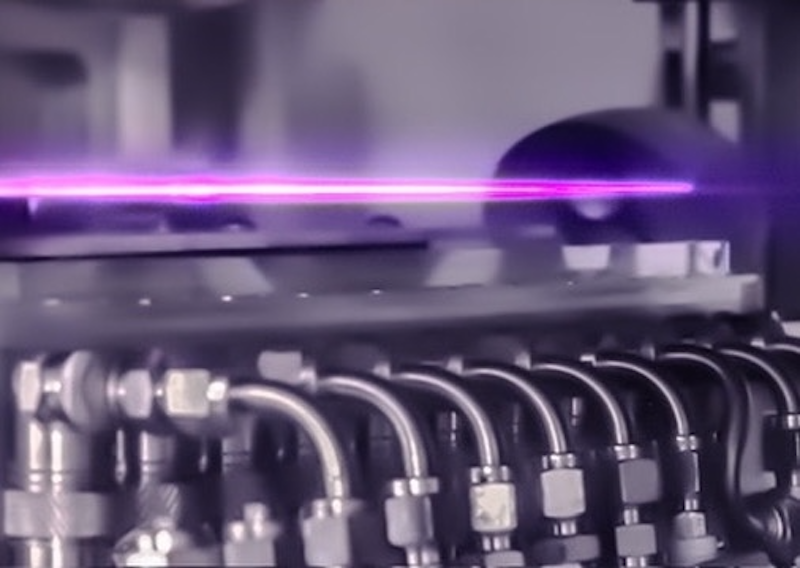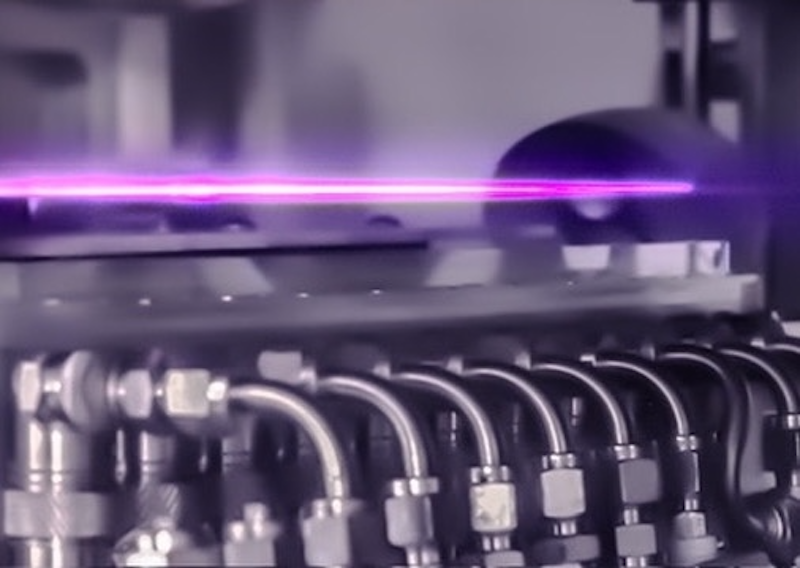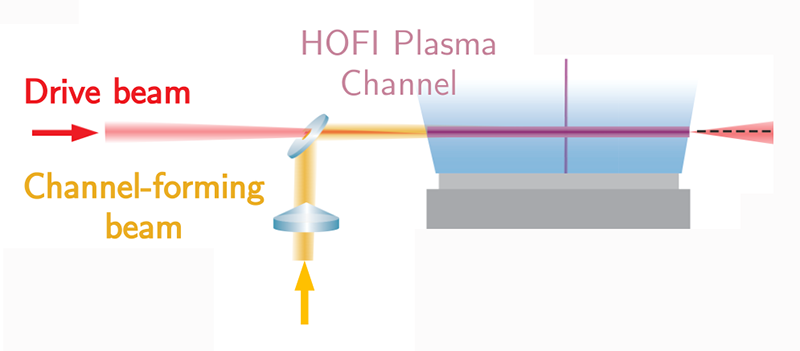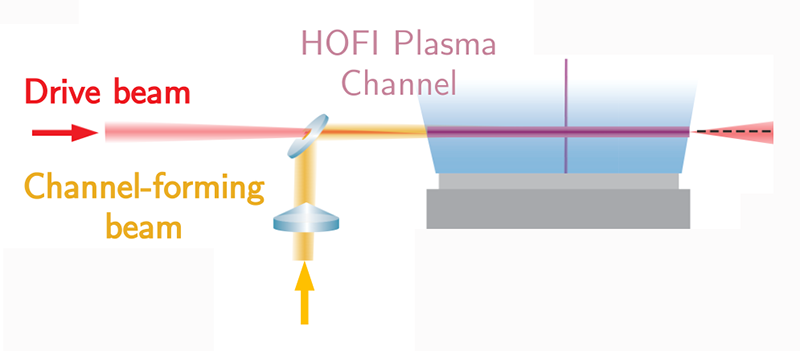Electrons Channel Surf to Ultrahigh Energies
Beams of electron bunches accelerated to energies of 10 GeV and above could benefit many scientific applications, from x-ray radiation sources to electron–positron colliders. Producing such beams typically requires large-scale scientific infrastructures. Even with today’s most advanced technology—involving radio-frequency cavities—accelerators longer than 100 m are required to achieve those electron energies. But scientists are developing a promising alternative approach, in which short, intense laser pulses are used to accelerate electrons in a plasma. Such “laser-wakefield” schemes have previously reached multi-GeV energies, but the highest-energy demonstrations lacked the controllability and quality required for the above-mentioned applications. Now Alex Picksley of Lawrence Berkeley National Laboratory’s BELLA Center, California, and collaborators have demonstrated controllable electron bunches at energies close to 10 GeV [1] (see also Podcast: A Milestone in Laser-Plasma Acceleration). The feat was made possible by combining plasma-wakefield particle acceleration with guided laser propagation in channels created by a laser in plasma [2–4]. The results bode well for the realization of compact devices—in particular, x-ray sources—based on laser-accelerated electrons.
Plasma wakefields are created by intense laser pulses propagating in a plasma. The pulses separate electrons from the plasma’s ions, creating waves of charge density in the wake of the pulses. These waves can create electric fields with strengths on the order of 100 GeV/m, which can accelerate beams of charged particles while keeping the beams focused [5]. The BELLA team has been progressively advancing this technique, achieving, within a single plasma stage, higher and higher electron-beam energies: 0.1 GeV in 2004, 1 GeV in 2006 [6], 4.2 GeV in 2014 (See Viewpoint: Power to the Electrons) [7], 7.8 GeV in 2019 [8], and now, in a collaboration with Howard Milchberg’s group at the University of Maryland, College Park, 9.2 GeV [1].
To excite a plasma wakefield, the intensity of the driving laser pulse must be extremely high (above 1018W/cm2), which can be achieved by tightly focusing a short (less than 1 ps) pulse. However, a focused pulse naturally diverges beyond the focal point, leading to an intensity drop that reduces the acceleration efficiency. In principle, intense laser pulses can “self-guide”: As they propagate in a plasma, they change its index of refraction such that the plasma acts as a waveguide. This process, however, is difficult to control and requires extremely high laser energies at the low plasma densities needed for high-energy laser-wakefield accelerators. A more reliable approach is to use plasma channels—plasma configurations that have a radially varying refractive index, much like lenses or optical fibers. These channels counteract the pulse’s natural divergence and allow for sustained wakefield driving over extended distances. And since they are formed from plasma, they can endure high laser intensities without being damaged, unlike most materials.
Plasma channels can be created by producing electrical discharges in a plasma or by heating it with lasers. Previous demonstrations have been limited in the ability to reach suitable values for the channel’s focusing strength and for other channel parameters, especially at the low plasma densities relevant for wakefield acceleration. For optimal performance, the channel’s guiding effect must exactly balance the tendency of the laser pulse to diverge, a condition known as matched guiding. Without this balance, the laser intensity profile would oscillate along the plasma, reducing acceleration efficiency and degrading beam quality.
The researchers achieved matched guiding by using “hydrodynamic optical-field-ionized” (HOFI) plasma channels (Fig. 1) and exploiting state-of-the-art diagnostics. HOFI channels are created by a short-pulse laser that heats the plasma’s electrons and induces a hydrodynamic shock, causing a rapid expansion of the plasma. The expansion produces the radially varying electron density needed for matched guiding. Recent work showed that this method not only works for plasma densities relevant to laser-wakefield schemes but also offers exceptional tunability and supports a wider range of channel parameters than other techniques. BELLA’s petawatt-laser facility is well suited to this approach, with a first beam line producing the main beam for wakefield acceleration and a recently installed second beam line providing the joule-level, short pulses required for creating the guiding plasma channels (Fig. 2).
Earlier this year, Aniculaesei and collaborators reported the acceleration of electron bunches to 10 GeV [9]. This demonstration, which used 118 J of energy in each laser drive pulse, was achieved without a plasma channel and through a complex combination of acceleration mechanisms. Using only 21.3 J in the drive pulse—a fivefold reduction in energy investment—Picksley and co-workers achieved similar energies in electron bunches. Furthermore, since only a single acceleration mechanism is involved, the new process is easier to control. This characteristic is essential for the production of high-quality beams in the future.
The new results show that the electron-bunch energies required for compact x-ray sources—including Thomson sources and x-ray free-electron lasers—can be reached within a single, all-plasma, laser-driven plasma-wakefield acceleration stage. Building practical machines will require progress on several factors, including beam quality and repetition rate. While the demonstrated scheme works at a repetition rate of 1 Hz (1 pulse per second), the plasma-channel approach was demonstrated up to 1 kHz [10]. The suitability for higher rates is a major advantage over competing techniques: The plasma channels are renewed with each pulse, and remaining heat can be efficiently transported away. The BELLA group is already spearheading the development of the needed laser technology with the upcoming kilohertz upgrade of BELLA, called k-BELLA (a name evoking the Italian expression for “what a beauty!”).
Reaching the energy levels needed for the most ambitious application of laser wakefields, a 10-TeV electron–positron collider, remains a longer-term goal. It will require linking together many 10-GeV plasma stages, as well as demonstrating substantial upgrades of various collider components. Work shall focus on integrating several device components into a single, compact scheme: plasma-based injectors for high-quality-beam production, plasma optics for beam manipulation, plasma mirrors for efficient coupling of laser pulses between acceleration stages, and plasma-based energy-recovery systems for energy-efficiency optimization. If these efforts are successful, laser-wakefield technology could offer a compelling, cheaper alternative to conventional high-energy accelerators.
Correction (3 January 2025): An earlier version of the text incorrectly quoted the electron-bunch charge obtained in the 2023 demonstration by Aniculasei et al. [9]. Their demonstration reached bunch charges of up to 340 pC, not 0.34 pC.
References
- A. Picksley et al., “Matched guiding and controlled injection in dark-current-free, 10-GeV-class, channel-guided laser-plasma accelerators,” Phys. Rev. Lett. 133, 255001 (2024).
- J. E. Shrock et al., “Guided mode evolution and ionization injection in meter-scale multi-GeV laser wakefield accelerators,” Phys. Rev. Lett. 133, 045002 (2024).
- R. J. Shalloo et al., “Hydrodynamic optical-field-ionized plasma channels,” Phys. Rev. E 97, 053203 (2018).
- A. Picksley et al., “Meter-scale conditioned hydrodynamic optical-field-ionized plasma channels,” Phys. Rev. E 102, 053201 (2020).
- T. Tajima and J. M. Dawson, “Laser electron accelerator,” Phys. Rev. Lett. 43, 267 (1979).
- W. P. Leemans et al., “GeV electron beams from a centimetre-scale accelerator,” Nature Phys. 2, 696 (2006).
- W. P. Leemans et al., “Multi-GeV electron beams from capillary-discharge-guided subpetawatt laser pulses in the self-trapping regime,” Phys. Rev. Lett. 113, 245002 (2014).
- A. J. Gonsalves et al., “Petawatt laser guiding and electron beam acceleration to 8 GeV in a laser-heated capillary discharge waveguide,” Phys. Rev. Lett. 122, 084801 (2019).
- C. Aniculaesei et al., “The acceleration of a high-charge electron bunch to 10 GeV in a 10-cm nanoparticle-assisted wakefield accelerator,” Matter Radiat. Extremes 9 (2023).
- A. Alejo et al., “Demonstration of kilohertz operation of hydrodynamic optical-field-ionized plasma channels,” Phys. Rev. Accel. Beams 25, 011301 (2022).







